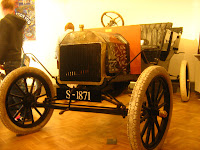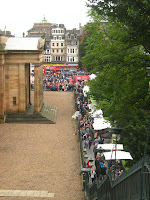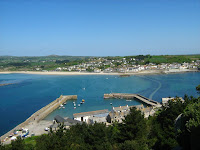We got off the coach in Glasgow at 6am and took the train to Balloch, then a local bus to Balmaha. And thus began our hike on the West Highlands Way.
The first day we walked from Balmaha to Inversnaid, a beautiful walk along Loch Lomond.


Exhausted after 14 miles walking, we wild camped in the woods near Inversnaid.
Day 2.
Beautiful setting, but woke up swamped by midges and in torrential rain. Love the outdoors :). Packed up the tend in the rain and off to the second day of walking.
First part, getting from Inversnaid to Invernan on a narrow and tiring footpath. Highlight of this path: seeing a polecat and a mountain goat in the woods! Otherwise, we got fairly wet in the torrential rain and struggled on the narrow path, as demonstrated below.


Walked and walked and walked through the rain till we finally stopped in the evening at a farm, near the ruins of a very old Christian priory and cemetery. Camped there and had a hot shower. Bliss.


Day 3.
On our way again, this time on a sunny pleasant day, enjoying the beautiful views. Finally arrived at Bridge of Orchy where we caught the train to Fort William.

Day 4.
Hiking up Ben Nevis, the highest peak in Britain. The weather was decent and the views were gorgeous! The route they say takes 8-9 hours but we managed to do it in under 7. Got down in plenty of time then to stop at the pub, have local ales and try the haggis (not bad!).

Day 5.
Another one of torrential, oppressive rain. Decided to stay around the campsite and see a bit of Fort William. Not too impressed, although two items in the local museum caught our attention. One is a Ford from 1901 they drove up Ben Nevis as a publicity stunt. Another, a dress decorated with green beetle wings.


Day 6.
Took the train from Fort William to Mallaig, they say it's one of the most beautiful train journeys in the world. From Mallaig, took the ferry to the Island of Skye. Landed at Armadale, a lovely little village.


Visited the Clan Donald estate and the museum. Really good museum, go if you have the chance.


Day 7.
Off on the 7am train to Edinburgh and the Fringe - largest arts festival in the world! Spent the day walking around the city, stopping to see the street theatre, finding great live music in various pubs, finishing the evening with a blues concert. The atmosphere is fantastic, definitely going back next year for longer!!



Day 8.
And sadly the last holiday day, made the most of it by visiting more of Edinburgh. Saw the beautiful hilltop castle, the Scottish Parliament building, enjoyed the wonderful individual cafes and generally moaned about having to go back home that evening...



Definitely going back to Scotland!! Not by night coach ever again though.


































